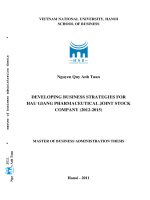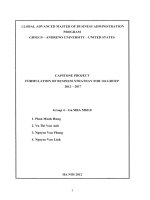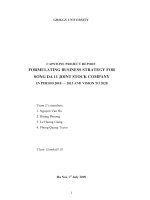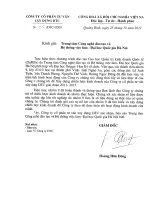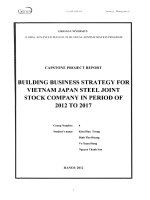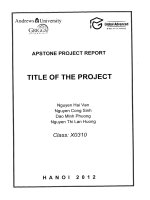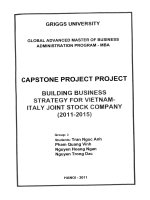Formulation of business strategy for Vietnam - Italy steel joint stock company by 2017
Bạn đang xem bản rút gọn của tài liệu. Xem và tải ngay bản đầy đủ của tài liệu tại đây (1.4 MB, 86 trang )
1
GROUP 08 - GaMBA.M0210
FORMULATION OF BUSINESS STRATEGY FOR
VIETNAM – ITALY STEEL JOINT STOCK
COMPANY BY 2017
CAPSTONE PROJECT REPORT
H A N O I 2 0 1 2
Hoang Xuan Anh
Vu Huy Quang
Le Chien Thang
Nguyen Duc Vinh
Class: GaMBA M0210
2
GROUP 08 - GaMBA.M0210
GRIGGS UNIVERSITY
GLOBAL ADVANCED MASTER OF BUSINESS ADMINISTRATION PROGRAM
CAPSTONE PROJECT REPORT
FORMULATION OF BUSINESS STRATEGY FOR
VIETNAM – ITALY STEEL JOINT STOCK
COMPANY BY 2017
Group Number:
08
Student’s name:
Hoang Xuan Anh
Vu Huy Quang
Le Chien Thang
Nguyen Duc Vinh
HANOI 2012
3
GROUP 08 - GaMBA.M0210
CONTENTS
GRIGGS UNIVERSITY 2
GLOBAL ADVANCED MASTER OF BUSINESS ADMINISTRATION PROGRAM 2
CAPSTONE PROJECT REPORT 2
HANOI 2012 2
1. Significance of the research 9
2. Objective of the research 10
3. Scope of the research 10
4. Research methodology 10
5. Expected results 11
6. Structure of the research: 11
CHAPTER 1 THEORETICAL BACKGROUND OF BUSINESS STRATEGY
FORMULATION 12
1.1. Concept and role of business strategy 12
1.1.1. Concept of business strategy 12
1.1.2. Basic characteristics of business strategy 12
1.1.3. Role of business strategy 13
1.2. Business strategy formulation process 13
1.2.1. Step 1: Determine visibility and its mission 14
1.2.2. Step 2: Business environment analysis of the enterprise 15
1.2.2.1. External environment analysis 15
1.2.2.2. Internal environment (inter-company environment) analysis 18
1.2.3. Step 3: Defining long-term goal and formulating the enterprise’s
development strategy 18
1.3. Tools used to evaluate and select business strategy 19
1.3.1. External Factor Evaluation (EFE) Matrix 19
1.3.2. Internal Factor Evaluation (IFE) Matrix 20
1.3.3. Competitive Profile Matrix (CPM) 20
1.3.4. SWOT Matrix (Strengths, Weaknesses, Opportunities, Threats): 21
1.3.5. Quantitative Strategic Planning Matrix (QSPM) 23
CHAPTER 2 ANALYSIS OF BUSINESS ENVIRONMENT OF VIETNAM – ITALY
STEEL JOINT STOCK COMPANY 25
2.1. Overview of Vietnam-Italy Steel Joint Stock Company 25
2.1.1. History of establishment and development 25
2.1.2. Organizational structure of Vietnam-Italy Steel Joint Stock Company 27
2.1.3. Major business lines 28
2.1.4. Vision and mission 29
2.2. Macro-environment analysis of VISCO 30
4
GROUP 08 - GaMBA.M0210
To analyze the macro-environment of VISCO, we use analysis tool PEST
+++
(Political- Economics- Socio-cultural- Technological) 30
2.2.1. Political segment 30
2.2.2. Economic segment 33
2.2.3. Social segment 35
2.2.4. Technological segment 35
2.3. Industry environment analysis of VISCO 36
2.3.1. Forecast on the market demand 36
2.3.2. Five Force Model analysis of VISCO 41
2.3.2.1. Rivalry and direct competitors of VISCO 41
2.3.2.2. Bargaining power of buyers 46
2.3.2.3. Bargaining power of suppliers 47
2.3.2.4. Threat of substitute products 49
2.3.2.5. Threat of new entrants 49
2.3.3. External environment evaluation of VISCO 50
2.3.3.1. Opportunities and threats of VISCO 50
2.3.3.2. External Factor Evaluation (EFE) Matrix 51
2.4. Internal environment analysis of VISCO 52
2.4.1. Production capacity 53
2.4.2. Marketing capacity 55
2.4.3. Financial capacity 60
2.4.4. Technological capacity 61
2.4.5. Human resources 63
2.4.6. Summary of VISCO’s internal environment evaluation 63
2.4.6.1. Strengths and weaknesses of VISCO. 63
2.4.6.2. Internal Factor Evaluation (IFE) Matrix 64
2.5. SWOT Matrix of VISCO 66
CHAPTER 3 FORMULATION OF BUSINESS STRATEGY BY 2017 FOR VIETNAM-
ITALY STEEL JOIN STOCK COMPANY - SOLUTIONS FOR STRATEGY
IMPLEMENTATION-RECOMMENDATIONS 70
3.1. Development orientation of VISCO by 2017. 70
3.2. Business strategy selection for VISCO by 2017. 70
3.2.1. Strategic alternatives formulated from SWOT Matrix 70
3.2.2. Strategy selection for VISCO to 2017 71
3.2.2.1. Market penetration strategy 71
3.2.2.2 Market development strategy 72
5
GROUP 08 - GaMBA.M0210
3.2.2.3 Product Development Strategy: 72
3.3. Strategic solutions of VISCO by 2017 76
3.3.1. Solution on organization (Song Da merging Steel Joint Stock Company SDS
into VISCO). 76
3.3.2. Solution on human resources 77
3.3.3. Solution on production 78
3.3.4. Solution on marketing 79
3.3.5. Solution on the market 80
3.3.6. Solution on distribution 80
3.3.7. Solution on finance 81
3.3.8. Solution on improving product quality 82
CONCLUSION 84
REFERENCES 85
6
GROUP 08 - GaMBA.M0210
LIST OF DIAGRAM
Diagram 1.1: Strategy formulation process 14
Diagram 1.2: SWOT Matrix 22
Diagram 2.1: Organizational structure of VISCO 28
Diagram 2.2: Product distribution diagram of Vietnam – Italy Steel Joint Stock
Company 59
LIST OF FIGURE
Figure 1.1: Five Force Model by Michael E.Porter 17
Figure 2.1 : Logo of Vietnam – Italy Steel Joint Stock Company (VISCO) 26
Figure 2.2. Signboard of VISCO 27
Figure 2.3: GDP growth rate of Vietnam in 2001-2011 period 34
Figure 2.4: Global steel output, April 2010 – September 2011 39
Figure 2.5: Growth rate of Vietnam’s steel industry 2007-2011 39
Figure 2.6: Market share of Vietnam’s steel industry in 2011 40
LIST OF TABLE
Table 2.1. Comparison of some basic criteria of VISCO’s competitors 42
Table 2.2. Competitive Profile Matrix (CPM) 45
Table 2.3. Opportunities and threats of VISCO 50
Table 2.4 External Factor Evaluation (EFE) Matrix 51
Table 2.5 Business and production results, 2008 –2011…………………… 52
Table 2.6: Budget allocated for advertising on the media 576
Table 2.7. Strengths and weaknesses of VISCO 633
Table 2.8 Internal Factor Evaluation (IFE) Matrix 64
Table 2.9. SWOT Matrix and combined strategies of VISCO 66
Table 3.1. Quantitative Strategic Planning Matrix (QSPM) 73
Table 3.2. Some targets for VISCO by 2017 83
7
GROUP 08 - GaMBA.M0210
COMMITMENT
Group 8-M0210 would like to commit that the content of this capstone
project report has not been submitted to any MBA program as well as other
courses.
Our effort has been shown in the content of the capstone project report.
We have applied the learned knowledge from the program logically and
combined with referential data to create a capstone project report with the
best quality.
8
GROUP 08 - GaMBA.M0210
ACKNOWLEGEMENT
At first, we would like to express our sincere thanks to the University
Management Board, professors, doctors, lecturers and staff at the Center for
Educational Technology and Career Development (ETC) – Vietnam National
University, Hanoi and Griggs University (USA) for their conscientious support
during our studying process.
This course provides us with an access to a modern education with advanced
and practical teaching method and applicable information to our work.
Regarding this capstone project report, we are grateful to Ass.Prf.Dr. Ngo
Kim Thanh for instructing and helping us complete the report – Global Advanced
Master of Business Administration Program 2012.
Thank you very much!
9
GROUP 08 - GaMBA.M0210
INTRODUCTION
1. Significance of the research
Over the past 10 years, Vietnam‟s economy always achieved high and stable
growth rates. Vietnam‟s accession to the World Trade Organization (WTO) has
opened up many opportunities for Vietnamese enterprises to expand the market,
raise production capacity and promote their brands in the region and the world, but
also brought in a lot of threats. These factors have great influence on the sustainable
development of enterprises. Steel is a key industry of Vietnam‟s economy, making
considerable contribution to GDP growth. However, the planning of the
government, industry and locality has pushed steel industry into a hot period of
growth without carefully considering the real purchasing power in the market,
leading to a supply-demand imbalance and fierce competition within domestic steel
industry. At the same time, it also creates conditions for steel imported from China
and ASEAN to penetrate into Vietnamese market, creating the chaos in steel
market. Therefore, to succeed, each steel manufacturing enterprise must have new
thinking and measures; and can utilize supporting means to grasp and process
information quickly and decisively to create competitive advantages. Understanding
the market regulations is the main basis to help enterprises control the game and be
proactively in all of their actions and decisions. In addition, if enterprises cannot
control the external information, internal problems, its core values and position,
they will fail right in domestic markets. Therefore, the strategy formulation for each
enterprise in the integration process is vital for the enterprise‟s survival and
development.
Under the market economy and the integration roadmap committed by Vietnam, the
competitive pressure will be more severe; and many enterprises (including those
have been established for a long time) will be lagged behind because they only
depend on experience to make decision, formulate simple plans and under-evaluate
the enterprises‟ management. This makes the enterprises be unable to formulate
10
GROUP 08 - GaMBA.M0210
strategies and position themselves. In the face of those urgent issues, applying our
learned knowledge from the Global Advanced Master of Business Administration
Program, group 8-M0210 including four members in which a member is working at
Vietnam – Italy Steel Joint Stock Company (VISCO) has selected the topic:
“Formulation of business strategy for Vietnam - Italy Steel Joint Stock Company
By 2017”. The group expects that the research results will bring in practical
implications to suggest to the Company‟s board of leaders new orientations to
sustain and enhance the position of VISCO in Vietnam‟s construction steel market.
2. Objective of the research
The topic “Formulation of business strategy for Vietnam - Italy Steel Joint
Stock Company By 2017” aims at following objectives:
Recognizing major opportunities and threats to the field of trading
construction steel, as well as strengths and weaknesses of VISCO.
Formulating a suitable business strategy for VISCO by 2017 by overcoming
weaknesses and promoting existing strengths to make full use of business
opportunities in order to maintain a stable and sustainable development.
3. Scope of the research
- Place of the research: Vietnam – Italy Steel Joint Stock Company and
Vietnam‟s steel market.
- Time of the research: bases on the business and production situation of
Vietnam – Italy Steel Joint Stock Company over the past four years (2008 †
2011).
4. Research methodology
- Analysis method: Using analysis technique - PEST
+++
, Five Force Model,
SWOT Matrix and I-E Matrix.
- Data collection method: data in internal reports from Sales Department, PR
Department, Planning-Investment Department of VISCO. Data from the Vietnam
11
GROUP 08 - GaMBA.M0210
Steel Association (VSA) and some reliable websites.
5. Expected results
- Recognizing strengths and weaknesses of VISCO, at the same time, being
able to find out the position of VISCO in the steel market with tough competition.
- Formulating business strategy for VIS-branded steel products at Vietnam –
Italy Steel Joint Stock Company by 2017.
At present, steel consumption market remains potential, but there will be
certain difficulties in the future amid the general development trend of domestic
steel industry and the penetration of companies in the region. Based on the analysis
of business environment, internal potential of the enterprise, strengths, weaknesses,
opportunities and threats affecting VISCO‟s operation, we provide the enterprise
with strategic alternatives and solutions to implement them in the general context of
the market.
The research results are the bases for VISCO to select appropriate business plans
to survive and develop with its own capacity.
6. Structure of the research:
Apart from the introduction and conclusion, the research includes three
chapters:
Chapter 1: Theoretical background of business strategy formulation
Chapter 2: Analysis of business environment of Vietnam – Italy Steel Joint
Stock Company.
Chapter 3: Selecting business strategy for Vietnam – Italy Steel Joint Stock
by 2017.
12
GROUP 08 - GaMBA.M0210
CHAPTER 1
THEORETICAL BACKGROUND OF BUSINESS STRATEGY
FORMULATION
1.1. Concept and role of business strategy
1.1.1. Concept of business strategy
The concept “strategy” has appeared for a long time and originated from the
field of military. At present, there are many concepts of strategy:
According to Pred R. David: “Business strategy is a mean to achieve long
term objectives”.
“Strategy indicates the determination of the basic long-term goals and the
objectives of an enterprise and the adoption of courses of action and the allocation
of resources necessary for carrying out these goals”, according to Alfred Chandler.
Strategic management is the process of:
- Investigating internal and external of the enterprise at present as well as in the
future;
- Defining missions and objectives to pursue;
- Deploying and checking the strategy implementation to help the enterprise
effectively utilize its resources and capacities to achieve expected goals.
1.1.2. Basic characteristics of business strategy
Long-term goals show the expected results from pursuing certain strategies.
Strategies represent the methods to achieve long-term objectives. The time for
realizing objectives and strategies must be suitable (normally from 2 to 5 years).
Business strategies only draft long-term orientation, while there must be a
combination of strategic goals with situational goals in the real business.
All important decisions in the process of formulating, determining,
organizing, checking and revising strategies must be paid attention by the top leader
of the enterprise.
Business strategies are always formulated, selected and implemented
13
GROUP 08 - GaMBA.M0210
based on the comparative advantages of the enterprise. This requires the
enterprise to correctly evaluate its business and production situation when
formulating strategy.
1.1.3. Role of business strategy
Business strategy is often the basis to determine specific business and
production targets and measure those business and production results. Generally, a
business strategy includes three groups of factors:
- Factors related to business environment of the enterprise.
- Factors related to the reality and measures of the enterprise‟s strategy
implementation.
- Factors related to the operation of the enterprise‟s management apparatus.
It can be said that business strategy has a decisive role to the success or
failure of the enterprise, specifically:
- Providing the enterprise‟s manager with a long-term vision.
- Being the basis for the enterprise‟s manager to make correct and timely
decisions.
- Helping the enterprise to make use of existing strengths and future
opportunities to cope with threats; overcome weaknesses; sustain and improve its
position.
1.2. Business strategy formulation process
There are many methods to formulate suitable business strategies with the
enterprise‟s conditions such as scale, market share, financial capacity, etc. Our
group would like to select the strategy formulation method presented in diagram
1.1. This process will be the core in the topic development of the group.
14
GROUP 08 - GaMBA.M0210
Diagram 1.1: Strategy formulation process
1.2.1. Step 1: Determine visibility and its mission
- Agreement on strategy formulation: is the cooperation and mutual support
Determine visibility
and its mission
External analysis
Internal analysis
Selection strategy
Strategy formulation:
- Corporate level strategy
- Business level strategy
- Functional level strategy
- Global strategy
Planning and
allocating resources
Putting strategy
into implementation
and reaching
integration
Organizing and
controlling
15
GROUP 08 - GaMBA.M0210
between strategists and participants in strategy implementation process to help:
+ Strategists understand more about the feasibility of the strategies
formulated and facilitate the implementation of those strategies.
+ Participants in strategy implementation process will understand more about
the strategies when implementing them.
+ Raising the feasibility of the formulated strategies.
- Defining mission of the enterprise: Mission is perceived as the reason for
existence and implication of the enterprise‟s establishment and existence. Mission
of the enterprise is its declaration to the society. Normally, mission includes some
contents such as customers, products or services, market, technology, philosophy,
interest to the community, employees, etc. The mission shows the enterprise‟s
future prospect. Mission is an important basis for the wise selection of objectives
and development strategies of the enterprise.
- Defining objective of the enterprise: Objective is the specification of
contents and the means to successfully implement the enterprise‟s mission
statement.
1.2.2. Step 2: Business environment analysis of the enterprise
Business environment of the enterprise includes internal and external
environment having direct or indirect influence on its existence and development.
Therefore, the analysis of internal and external environment of the enterprise is very
necessary to the enterprise‟s strategy formulation.
1.2.2.1. External environment analysis
Macro-environment analysis (using PEST
+++
Model Political-
Economics- Socio-cultural- Technological…)
The external environment analysis helps us recognize opportunities and
threats to map out appropriate strategies for the enterprise. The external
environment analysis is carried out with environments related to the existence and
16
GROUP 08 - GaMBA.M0210
development of the enterprise, including:
- Economic segment: The economic segment analysis is to determine the
trend of product consumption demand and the capacity to supply materials, human
resources, etc. for production and the enterprise management. The segment includes
some major factors such as gross domestic product, income per capita, monetary
policy, import-export tariff of commodities and services, international economic
integration, population growth (decrease) rate, etc. There must be clear
understanding and evaluation on the socio-economic development planning of the
government and localities.
- Political and legal segment: Enterprises need to grasp political trend,
internal & external relation policies, guidelines and policies of the Party and laws of
the State on the enterprise‟s development.
- Technical-technological segment: The appearance of an increasing
number of new technologies creates opportunities as well as threats for enterprises.
New technologies help produce new products with lower prices and shorten
products‟ lifespan.
- Socio-cultural segment: The consumption characteristics, custom, lifestyle
or culture of each locality and ethnic groups will have influence on the demand and
taste of consumers who consume enterprises‟ products.
- Demographic segment: The scale, growth rate and structure of the
population will have influence on consumption demand and human resource
supplies.
Micro-environment (industry environment) analysis
17
GROUP 08 - GaMBA.M0210
Figure 1.1: Five Force Model by Michael E.Porter
- New entrants: When new competitors penetrate in the industry, the market
share and profit of the enterprise will decrease. To protect its competitive position,
the enterprise needs to reinforce entry barriers by some measures such as
diversifying products, exploiting the existing advantages in terms of production
scale, market share, geographical location, brand, etc. to raise the initial investment
capital, slow capital recovery, reduce competitiveness of the new entrants, so they
will have to withdraw from the market.
- Substitute products: The quick development of science and technology is
the conditions for the appearance of substitute products. Substitute products will
threaten the market share and limit potential profit of the enterprise. Therefore, the
enterprise needs to non-stop apply science and technology to raise labor
productivity so as to lower prices of products and services, and heighten quality &
functions of services to enhance its competitiveness.
New
entrants
Industry competitors
Rivalry among existing
firms
Buyers
Suppliers
Substitutes
Threat of new
entrants
Bargaining
power of
buyers
Threat of substitute
products and service
Bargaining
power of
suppliers
18
GROUP 08 - GaMBA.M0210
- Buyers: The trust of customers is very meaningful to an enterprise.
However, when buyers have advantages, they will put pressure on the enterprise;
for example, they will force prices down or require deferred payment, etc.
- Suppliers: include enterprises providing inputs such as materials, machine,
equipment, finance, human resources, etc. When suppliers have advantages, they
will cause disadvantageous pressure on the enterprise such as setting high selling
prices, shortening the deadline of payment, etc.
- Competitors: This is a regular pressure which directly threatens the
enterprise. When the competitive pressure among enterprises increases, it will
threaten the position and existence of the enterprise.
1.2.2.2. Internal environment (inter-company environment) analysis
Internal environment of an enterprise includes factors that the enterprise can
control firmly such as management, production, finance, accounting, material
supply, marketing, public relations (PR), human resources, information system, etc.
The internal environment analysis helps the enterprise identify its strengths and
weaknesses to formulate suitable strategies which can be implemented in the near
future.
1.2.3. Step 3: Defining long-term goal and formulating the enterprise’s
development strategy
- Long-term objective is the enterprise‟s expected results set out in quite a
long period. The time for implementing a long-term goal or a strategy is often over
two years. In the strategy implementation process, to achieve the long-term goal, the
enterprise can divide it into many short-term objectives in accordance with shorter
periods.
- Goal setting is a process of judgment combined with the forecast on
demand for the products, the sales, total costs and resources of the enterprise. The
forecast on demand helps the enterprise to determine the type and quantity of the
19
GROUP 08 - GaMBA.M0210
products or services that they need to produce and supply in the future. Through the
forecast on demand, managers can decide the production scale and operation of the
enterprise to set the basis for making projection on the finance and human resources
in the enterprise.
- There are many methods to forecast. Normally, the forecast in a straight
way will be used to forecast the future market demand based on the analysis of data
in the past.
- Besides, another factor in the forecast that we need to pay attention is
lifespan of products. It is an important factor needing to be considered carefully in
the forecasting process, especially for long-term forecast.
- When the objective is formulated rationally, it will be the motivation and
measure for the strategy implementation process. Normally, the objective must
ensure feasibility, flexibility, specification, consistency and time of implementation.
1.3. Tools used to evaluate and select business strategy
To formulate a business strategy, many methods and tools of planning can be
employed. This topic only selects some tools introduced below because we believe
that they will facilitate the development strategy formulation of Vietnam – Italy
Steel Joint Stock Company.
1.3.1. External Factor Evaluation (EFE) Matrix
External Factor Evaluation (EFE) Matrix allows evaluating major influence
of the external environment on the enterprise. EFE Matrix is deployed through five
steps:
Step 1: Listing key external factors affecting the enterprise‟s operation.
Step 2: Assigning a weight from 0.0 (indirect, least important) to 1.0 (direct,
most important) for each factor. The classification shows the corresponding
importance of factors to the success of the enterprise in the industry.
Step 3: Assigning a rating from 1 (weak response and influence) to 4 (strong
response and influence) for each critical success factor to show the response of the
20
GROUP 08 - GaMBA.M0210
enterprise‟s current strategy to these factors.
Step 4: Multiplying the weight of each factor with respective rating to
determine the total weighted score.
Step 5: Adding the total weighted score of factors with the sector of the
enterprise. The average score is 2.5. If the total weighted score is lower than 2.5, it
shows a weak response. If it is above 2.5, it will show a strong and positive
response to the enterprise.
Advantage: Forming an overall picture about external factors affecting the
enterprise‟s competitiveness.
Disadvantage: The rating of each factor as well as determination of the importance
of each factor remains subjective.
1.3.2. Internal Factor Evaluation (IFE) Matrix
With similar steps of implementation and method of calculating weighted
score of External Factor Evaluation Matrix, Internal Factor Evaluation Matrix is a
tool to evaluate the strengths, weaknesses and available resources of the enterprise.
Advantages: Forming an overview about the internal of the enterprise with
specific strengths and weaknesses having influence on the competitiveness of the
enterprise.
Disadvantages: Similar to EFE Matrix.
1.3.3. Competitive Profile Matrix (CPM)
Competitive Profile Matrix is formed to give out comparison between an
enterprise with its major competitors in the industry. The comparison is based on
factors affecting the competitiveness of enterprises in the industry. It helps
managers recognize the strengths and weaknesses of the enterprise compared to its
competitors, define its competitive advantages and weaknesses needing to be
overcome. There are five steps to form a Competitive Profile Matrix:
21
GROUP 08 - GaMBA.M0210
Step 1: Listing about 10 key factors having strong influence on the
competitiveness of enterprises in the industry.
Step 2: Assigning a weight from 0.0 (not important) to 1.0 (very important)
for each factor. The weight of each factor depends on its influence on the
competitiveness of enterprises in the industry. The total weighted score of all factors
must be equal to 1.0.
Step 3: Assigning a rating from 1 to 4 for each factor. The rating of each
factor depends on the enterprise‟s response to each factor, in which 4 is superior, 3:
above average, 2: average, 1: poor.
Step 4: Multiplying the weight of each factor with its rating to find out the
weighted score of each factor.
Step 5: Adding the weighted score of all factors to find out the total
weighted score of the matrix.
Evaluation: Comparing the total weighted score of the enterprise with its
major competitors in the industry to evaluate its competitiveness.
1.3.4. SWOT Matrix (Strengths, Weaknesses, Opportunities, Threats):
- SWOT Matrix evaluates strengths, weaknesses, opportunities and threats.
The objective of environment analysis to recognize opportunities, threats as well as
strengths and weaknesses that the enterprise has been facing in its operational
process to set the basis for the enterprise‟s strategy formulation. SWOT analysis is a
tool for summarizing the results of environment analysis and formulating strategy.
- Major opportunities: are factors which product between the influence on the
enterprise when they are utilized and the probability that the enterprise can take
advantage of those opportunities is very high.
- Major threats: are factors which product between influence when the threats
occur to the enterprise and the probability of those threats has the highest value.
- Defining key strengths and weaknesses: the process of evaluating and
analyzing internal environment of the enterprise points out many factors, but it is
22
GROUP 08 - GaMBA.M0210
important to figure out key factors affecting the competitive position and
implementation of the enterprise‟s strategy. Here, we need to consider factors as
activities in the system and compare with general standards of the industry and
major competitors.
- Combining internal and external factors: after defining basic internal and
external factors, applying a process with following steps to analyze and suggest
strategies:
Step 1: Listing key internal and external factors on the cells of SWOT
Matrix.
Step 2: Combining each pair logically. Formulating strategies by combining
S/O, S/T, W/O, W/T.
+ S/O: Using which strengths to best exploit external opportunities?
+ S/T: Using which strengths to cope with external threats?
+ W/O: Overcoming which weaknesses to create good conditions for the
utilization of external opportunities. Which opportunities need to be exploited to
overcome the current weaknesses?
+ W/T: Which weaknesses need to be overcome to reduce the current
threats?
Step 3: Combining four factors S+W+O+T to form a strategy which helps the
enterprise use strengths to exploit opportunities, and overcome weaknesses to
reduce threats.
Step 4: Summarizing and reconsidering strategies. Grouping strategies and
coordinating strategies into a system with mutual support.
SWOT
Opportunities
Threats
Strengths
SO strategies
ST strategies
Weaknesses
WO strategies
WT strategies
Diagram 1.2: SWOT Matrix
23
GROUP 08 - GaMBA.M0210
Advantages:
- Figuring out strengths and weaknesses of the enterprise as well as external
opportunities and threats.
- Formulating strategies by combining specific strengths, weaknesses,
opportunities and threats for the enterprise to have solutions to implement.
Disadvantages: SWOT Matrix helps map out feasible strategic alternatives
rather than selecting and deciding which strategy is the best. Therefore, the selection
of which strategy to develop the enterprise has not been solved in the matrix.
1.3.5. Quantitative Strategic Planning Matrix (QSPM)
According to Fred R.David, QSPM Matrix uses input information from IFE
Matrix, EFE Matrix, Competitive Profile Matrix, SWOT Matrix and Grand Strategy
Matrix to objectively evaluate which is the best strategic alternative. Six steps to
develop a QSPM Matrix:
Step 1: Listing important external opportunities/threats and internal
strengths/weaknesses of the enterprise.
Step 2: Assigning a weight to each internal and external critical success
factor. This step is similar to IFE and EFE matrices.
Step 3: Listing strategic alternatives that the enterprise should consider to
implement. Gathering strategies into separate group if it is possible.
Step 4: Finding out the attractiveness score (AS) of each strategy. The
attractiveness score is rated as follows: 1- not acceptable; 2- possibly acceptable; 3-
probably acceptable; 4- most acceptable. If the success factors do not have influence
on the strategy selection, do not mark them.
Step 5: Calculating the total attractiveness score (TAS) by multiplying the
weight (step 2) with the attractiveness score (step 4) in each row.
Step 6: Calculating the sum total attractiveness score by adding all total
attractiveness scores in each strategy column of the QSPM. Higher scores point at a
more attractive strategy.
24
GROUP 08 - GaMBA.M0210
Each of the above-mentioned tools of strategy formulation has their own
advantages and disadvantages. Therefore, there must be flexible selection of
strategy to suit each specific situation and condition.
25
GROUP 08 - GaMBA.M0210
CHAPTER 2
ANALYSIS OF BUSINESS ENVIRONMENT OF VIETNAM – ITALY
STEEL JOINT STOCK COMPANY
2.1. Overview of Vietnam-Italy Steel Joint Stock Company
2.1.1. History of establishment and development
Implementing the strategy of becoming a strong economic group of the
country and aiming at multi-fields, multi-businesses and product diversification, on
January 2, 2002m SongDa Holdings decided to invest in a new and synchronous
steel milling line with the capacity of 250,000 tons per year. This is a modern steel
milling line with the total investment of VND 276 billion, supplied and transferred
by Danieli-Italy – the world‟s no.1 group in terms of steel manufacturing
technology. With the effort of the master investor and contractors, the plant
officially came into operation on June 14, 2003. Pursuant to the Decision No.
1748/QD-BXD dated December 26, 2003 of the Minister of Construction on
converting a number of State-owned enterprises into joint stock companies, on
February 11, 2004, Vietnam – Italy Steel Joint Stock Company organized its first
shareholders‟ meeting and was officially operated as a joint stock company from
February 20, 2004 with the abbreviated English name - VISCO.
The plant is situated in an area of about 8ha next to the National Road no. 5,
connecting Hanoi with Hai Phong (Km 24+500, Pho Noi A Industrial Park – Giai
Pham – Yen My – Hung Yen).
On December 23, 2006, Vietnam – Italy Steel Joint Stock Company was
officially listed on Ho Chi Minh City Stock Exchange (HOSE) with stock code –
VIS. With high annual growth rates of business results and dividend, VIS has
become a prestigious stock code of both domestic and foreign investors on HOSE.
After nearly 10 years of establishment and development, VISCO has
affirmed its position in domestic steel market by supplying diverse products: from
wire rod Φ5,5-Φ8 to deformed bar with diameter D10 † D40, manufactured in
